本文主要讲解关于Spring Boot:Web应用开发之增删改查的实现相关内容,让我们来一起学习下吧!
Spring Boot
- 前言
- 实现增删改查功能
前言
增删改查功能作为 Web 应用中的基础且重要的组成部分,是基本的数据库操作,也是实现业务逻辑和功能的关键要素。下面简单介绍使用 Spring Boot 实现增删改查的功能。
实现增删改查功能
在上一章 Spring Boot:Web应用开发之登录与退出的实现 文章的案例基础上,进行实现增删改查的功能。
简单示例: 首先,创建一个 PublicTemplate.html ,将 html 的公共代码抽离到这页面上,方便其他页面进行复用(使用方式:th:replace=“模版名称::模版⽚段名称”)
<!DOCTYPE html>
<html lang="en">
<head>
<meta charset="UTF-8">
<title>公共页面-抽离与复用</title>
</head>
<body>
<!-- th:fragment 属性来定义被包含的模版⽚段,以供其他模版使用。模版⽚段名称为 top -->
<div class="header" th:fragment="header">
主页面的头部区域
</div>
<div class="center">
<!-- 通用侧边栏区域 -->
<div class="sidebar" th:fragment="sidebar">
<!-- 增强效果设置:th:class="${isActive=='Main.html'?'active':''}" 当切换到该页面时,内容设定为 active 的样式 -->
<a href="#" th:class="${isActive=='Main.html'?'active':''}" th:href="@{Main.html}">主页</a> <br>
<a href="#" th:class="${isActive=='UserList.html'?'active':''}" th:href="@{UserList.html}">用户列表</a> <br>
<a th:href="@{/logout.html}">退出</a>
</div>
</div>
<div class="footer" th:fragment="footer">
主页面的脚部区域
</div>
</body>
</html>
创建需要用到的页面,有公共的代码便使用 th:replace 调用
Main.html:主页面
<!DOCTYPE html>
<html lang="en">
<head>
<meta charset="UTF-8">
<title>MainDemo</title>
<!-- 存放 css 文件默认在 static 目录下 -->
<link rel="stylesheet" type="text/css" th:href="@{/css/PublicCss.css}">
</head>
<body>
<!-- th:replace 替换整个标签到引入的文件。使用方式——th:replace="模版名称::模版⽚段名称" -->
<div th:replace="PublicTemplate::header"></div>
<dic class="center">
<!-- 增强效果设置:(isActive='Main.html') -->
<div th:replace="PublicTemplate::sidebar(isActive='Main.html')"></div>
<div class="main">
主页面内容
</div>
</dic>
<div th:replace="PublicTemplate::footer"></div>
</body>
</html>
UserList.html:显示用户列表页面
<!DOCTYPE html>
<html lang="en">
<head>
<meta charset="UTF-8">
<title>UserListDemo</title>
<!-- 存放 css 文件默认在 static 目录下 -->
<link rel="stylesheet" type="text/css" th:href="@{/css/PublicCss.css}">
</head>
<body>
<!-- th:replace 替换整个标签到引入的文件。使用方式——th:replace="模版名称::模版⽚段名称" -->
<div th:replace="PublicTemplate::header"></div>
<dic class="center">
<div th:replace="PublicTemplate::sidebar(isActive='UserList.html')"></div>
<div class="main">
<form th:action="UserSearch.html" method="post">
<input type="text" name="searchByUsername" />
<input type="submit" value="查询" />
<a th:href="@{/UserAdd.html}">添加</a>
</form>
<table>
<tr>
<td>id</td>
<td>账号</td>
<td>密码</td>
<td>注册时间</td>
<td>地址</td>
<td>操作</td>
</tr>
<tr th:each="user:${users}">
<td th:text="${user.id}"></td>
<td th:text="${user.username}"></td>
<td th:text="${user.password}"></td>
<td th:text="${user.regDate}"></td>
<td th:text="${user.address}"></td>
<td>
<a th:href="@{/UserDelete.html(id=${user.id})}" onclick="return confirm('确定要删除吗?')">删除</a>
<a th:href="@{/UserUpdate.html(id=${user.id})}">修改</a>
</td>
</tr>
</table>
</div>
</dic>
<div th:replace="PublicTemplate::footer"></div>
</body>
</html>
UserAdd.html:添加用户页面
<!DOCTYPE html>
<html lang="en">
<head>
<meta charset="UTF-8">
<title>UserAddDemo</title>
</head>
<body>
<form th:action="@{/UserAdd.html}" method="post">
账号:<input type="text" name="username"/> <br>
密码:<input type="text" name="password"/> <br>
地址:
<select name="address.id">
<option th:value="${address.id}" th:each="address:${addresses}">[[${address.addressInfo}]]</option>
</select> <br>
<input type="submit" th:value="添加">
</form>
</body>
</html>
UserUpdate.html:修改用户页面
<!DOCTYPE html>
<html lang="en">
<head>
<meta charset="UTF-8">
<title>UserUpdateDemo</title>
</head>
<body>
<div class="main">
<form th:action="@{/UserUpdate.html}" method="post">
<input type="hidden" name="id" th:value="${user.id}">
账号:<input type="text" name="username" th:value="${user.username}"/> <br>
密码:<input type="text" name="password" th:value="${user.password}"/> <br>
注册时间:<input type="text" name="regDate" th:value="${#dates.format(user.regDate,'yyyy-MM-dd HH:mm:ss')}"/> <br>
地址:
<select name="address.id">
<option th:value="${address.id}" th:selected="${user.address.id == address.id}" th:each="address:${addresses}">[[${address.addressInfo}]]</option>
</select> <br>
<input type="submit" th:value="修改">
</form>
</div>
</body>
</html>
然后,在 User 实体类上使用 @DateTimeFormat 注解指定日期样式(否则在修改注册时间时,会出现类型转换问题),再创建一个 Address 类
package cn.edu.SpringBootWebDemo.Entity;
import jakarta.persistence.*;
@Entity
@Table(name = "address")
public class Address {
private int id;
private String addressInfo; // 地址详情
@Id
@GeneratedValue(strategy = GenerationType.IDENTITY) // 自增
public int getId() {
return id;
}
public void setId(int id) {
this.id = id;
}
@Column(name = "address_info") // 指定字段名
public String getAddressInfo() {
return addressInfo;
}
public void setAddressInfo(String addressInfo) {
this.addressInfo = addressInfo;
}
@Override
public String toString() {
return "Address{" +
"id=" + id +
", addressInfo='" + addressInfo + ''' +
'}';
}
}
随之,在 UserDao 接口上声明一个模糊查询方法,在 AddressDao 接口上直接继承 JpaRepository<实体类,主键类型> 即可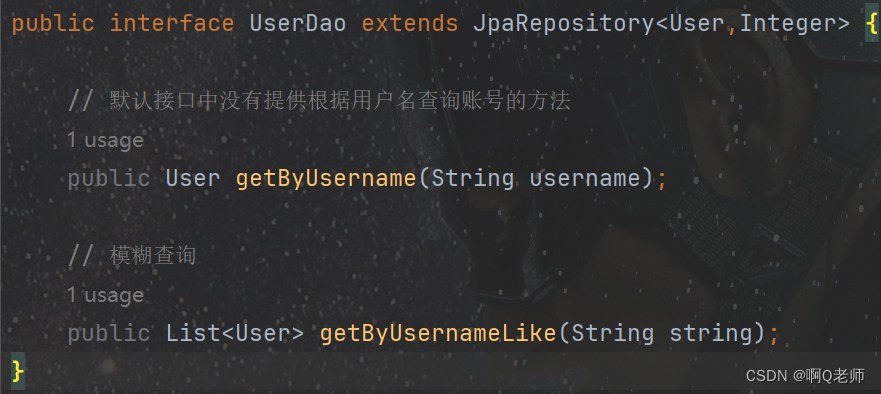

接着,在 Service 包内创建一个 UserService 接口,声明增删改查方法,并创建一个 UserServiceImpl 实现类实现该接口方法; AddressService 接口与 AddressServiceImpl 实现类同理
UserService 接口:
package cn.edu.SpringBootWebDemo.Service;
import cn.edu.SpringBootWebDemo.Entity.User;
import java.util.List;
public interface UserService {
public User login(User user);
//增删改查
public void add(User user);
public void delete(int id);
public void update(User user);
public User get(int id);
public List<User> getALLUsers();
public List<User> getByUsernameLike(String string);
}
UserServiceImpl 实现类:
package cn.edu.SpringBootWebDemo.Service;
import cn.edu.SpringBootWebDemo.Dao.UserDao;
import cn.edu.SpringBootWebDemo.Entity.User;
import jakarta.transaction.Transactional;
import org.springframework.beans.factory.annotation.Autowired;
import org.springframework.stereotype.Service;
import java.util.List;
@Service("userService")
@Transactional // 放在类上,类上的所有方法都支持事务;也可以只放在一个方法上,只指定那个方法支持事务
public class UserServiceImpl implements UserService{
@Autowired
private UserDao userDao;
@Override
public User login(User user) {
// 根据用户名查询有没有对应的账号
User user1 = userDao.getByUsername(user.getUsername());
// 判断是否为空或密码错误,登录失败返回 null
if (user1 == null) return null;
if(!user1.getPassword().equals(user.getPassword())) return null;
// 返回 User 对象,登录成功
return user1;
}
@Override
public void add(User user) {
userDao.save(user);
}
@Override
public void delete(int id) {
userDao.deleteById(id);
}
@Override
public void update(User user) {
userDao.saveAndFlush(user);
}
@Override
public User get(int id) {
return userDao.findById(id).get();
}
@Override
public List<User> getALLUsers() {
return userDao.findAll();
}
@Override
public List<User> getByUsernameLike(String string) {
return userDao.getByUsernameLike(string);
}
}
AddressService 接口:
package cn.edu.SpringBootWebDemo.Service;
import cn.edu.SpringBootWebDemo.Entity.Address;
import java.util.List;
public interface AddressService {
public void add(Address address);
public void delete(int id);
public void update(Address address);
public Address get(int id);
public List<Address> getAllAddress();
}
AddressServiceImpl 实现类:
package cn.edu.SpringBootWebDemo.Service;
import cn.edu.SpringBootWebDemo.Dao.AddressDao;
import cn.edu.SpringBootWebDemo.Entity.Address;
import org.springframework.beans.factory.annotation.Autowired;
import org.springframework.stereotype.Service;
import java.util.List;
@Service
public class AddressServiceImpl implements AddressService{
@Autowired
private AddressDao addressDao;
@Override
public void add(Address address) {
addressDao.save(address);
}
@Override
public void delete(int id) {
addressDao.deleteById(id);
}
@Override
public void update(Address address) {
addressDao.saveAndFlush(address);
}
@Override
public Address get(int id) {
return addressDao.findById(id).get();
}
@Override
public List<Address> getAllAddress() {
return addressDao.findAll();
}
}
再在 Controller 包内的 UserController 控制类上处理用户相关的 HTTP 请求
package cn.edu.SpringBootWebDemo.Controller;
import cn.edu.SpringBootWebDemo.Entity.Address;
import cn.edu.SpringBootWebDemo.Entity.User;
import cn.edu.SpringBootWebDemo.Service.AddressService;
import cn.edu.SpringBootWebDemo.Service.UserService;
import jakarta.servlet.http.HttpSession;
import org.springframework.beans.factory.annotation.Autowired;
import org.springframework.stereotype.Controller;
import org.springframework.ui.Model;
import org.springframework.web.bind.annotation.GetMapping;
import org.springframework.web.bind.annotation.PostMapping;
import java.util.Date;
import java.util.List;
@Controller
public class UserController {
@Autowired
private UserService userService;
@Autowired
private AddressService addressService;
@GetMapping("/Login.html")
public String login(HttpSession httpSession){
// 成功登录后不能再返回登录页面,而是跳转到主页
boolean flag = httpSession.getAttribute("loginUser")==null?true:false;
if (flag){
return "Login";
}else {
return "redirect:/Main.html";
}
}
@GetMapping("/Main.html")
public String main(){
return "Main";
}
// 判断登录
@PostMapping("/Login.html")
public String login(User user, HttpSession httpSession, Model model){
// 控制层——接受页面的账号和密码。调用服务层的 login 方法,判断登录是否成功。
// 成功将返回的 user 对象保存到 session 的域空间;反之返回一个错误提示。
User user1 = userService.login(user);
if(user1 != null) {
// 将返回的 user 对象保存到 session 的域空间,页面跳转到主页中
httpSession.setAttribute("loginUser",user1);
return "redirect:/Main.html";
}else {
// 登录失败,返回错误提示
model.addAttribute("loginError","用户名或密码错误!");
return "Login";
}
}
// 退出
@GetMapping("/logout.html")
public String logout(HttpSession httpSession){
// 通过 invalidate 方法清空 httpSession 里的内容
httpSession.invalidate();
return "redirect:/Login.html";
}
// 显示用户
@GetMapping("/UserList.html")
public String userlist(Model model){
List<User> users = userService.getALLUsers();
model.addAttribute("users",users);
System.out.println(users);
return "UserList";
}
// 模糊查询用户
@PostMapping("/UserSearch.html")
// 接受的参数,searchByUsername 名字与页面 input 标签的 name 属性值一致
public String userSearch(String searchByUsername,Model model){
List<User> users = userService.getByUsernameLike("%" + searchByUsername + "%");
model.addAttribute("users",users);
return "UserList";
}
// 先获取所有的地址信息,再进行添加用户
@GetMapping("/UserAdd.html")
public String addUser(Model model){
List<Address> addresses = addressService.getAllAddress();
model.addAttribute("addresses",addresses);
return "UserAdd";
}
@PostMapping("/UserAdd.html")
public String addUser(User user){
user.setRegDate(new Date());
userService.add(user);
return "redirect:/UserList.html";
}
// 修改实现:1.点击修改按钮,打开修改页面
@GetMapping("/UserUpdate.html")
public String updateUser(Model model,Integer id){
// 获取指定用户信息
User user = userService.get(id);
model.addAttribute("user",user);
// 获取指定地址信息
List<Address> addresses = addressService.getAllAddress();
model.addAttribute("addresses",addresses);
return "UserUpdate";
}
// 2.修改实现
@PostMapping("/UserUpdate.html")
public String updateUserAchieve(User user){
userService.update(user);
return "redirect:/UserList.html";
}
// 删除用户
@GetMapping("/UserDelete.html")
public String deleteUser(Integer id){
userService.delete(id);
return "redirect:/UserList.html";
}
}
最后,在 SpringBootWebDemoApplication 启动类上使用 @EnableTransactionManagement 注解开启事务,并启动 Spring Boot 进行测试
package cn.edu.SpringBootWebDemo;
import org.springframework.boot.SpringApplication;
import org.springframework.boot.autoconfigure.SpringBootApplication;
import org.springframework.context.annotation.Bean;
import org.springframework.jdbc.datasource.DataSourceTransactionManager;
import org.springframework.transaction.PlatformTransactionManager;
import org.springframework.transaction.annotation.EnableTransactionManagement;
import javax.sql.DataSource;
@EnableTransactionManagement // 开启事务
@SpringBootApplication
public class SpringBootWebDemoApplication {
// 获取事务管理器类型
// @Bean
// public Object testBean(PlatformTransactionManager platformTransactionManager){
// System.out.println("事务管理器类型:" + platformTransactionManager.getClass().getName());
// return new Object();
// }
// 指定事务管理器,设置后会覆盖默认的事务管理器
// @Bean
// public PlatformTransactionManager manager(DataSource dataSource){
// return new DataSourceTransactionManager(dataSource);
// }
public static void main(String[] args) {
SpringApplication.run(SpringBootWebDemoApplication.class, args);
}
}
3.在显示用户列表页面上,进行模糊查询,输入 “刘” 点击查询 模糊查询结果:
模糊查询结果:
4.在显示用户列表页面上,点击添加,进入添加页面,输入用户信息,点击添加用户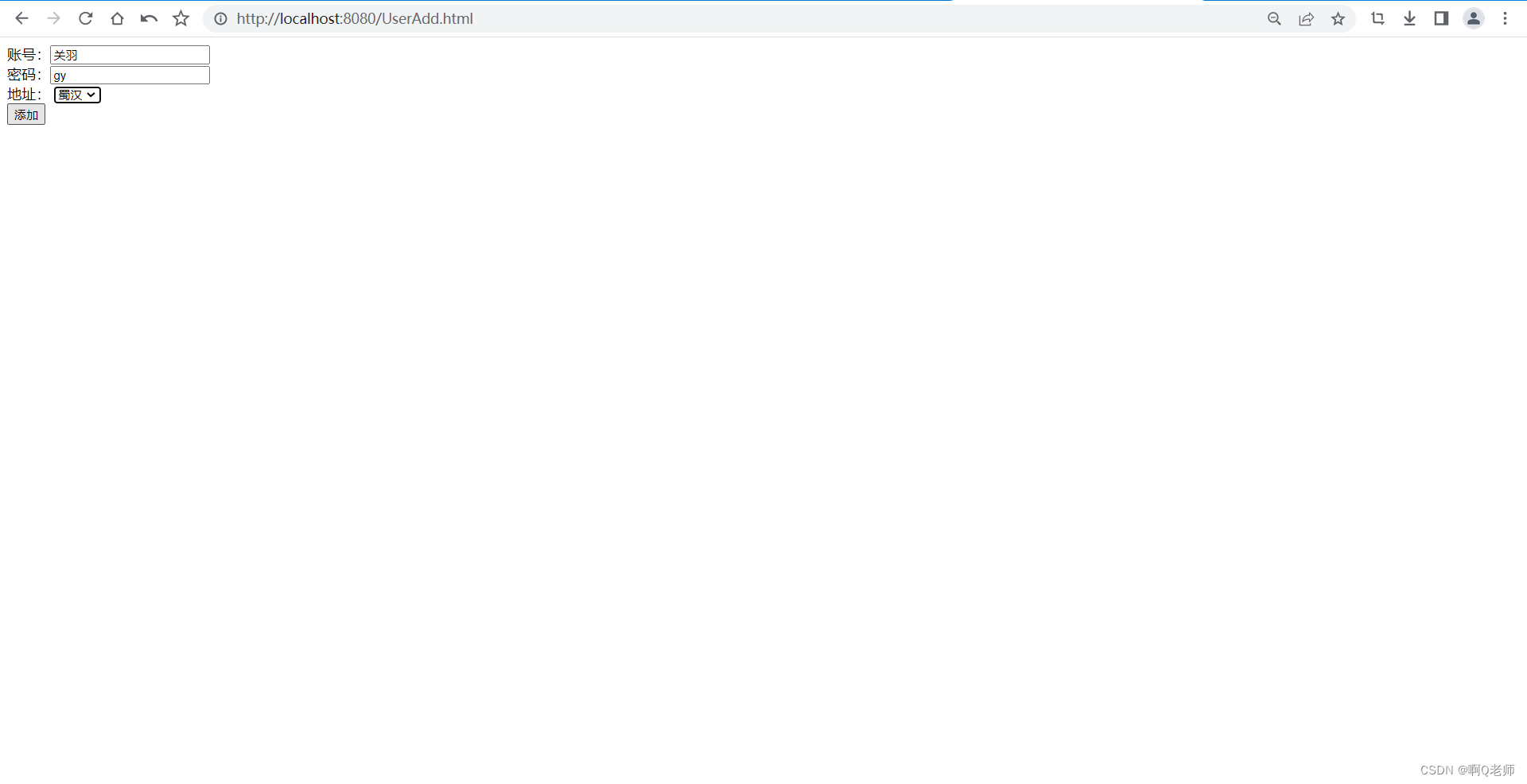 添加用户结果:
添加用户结果: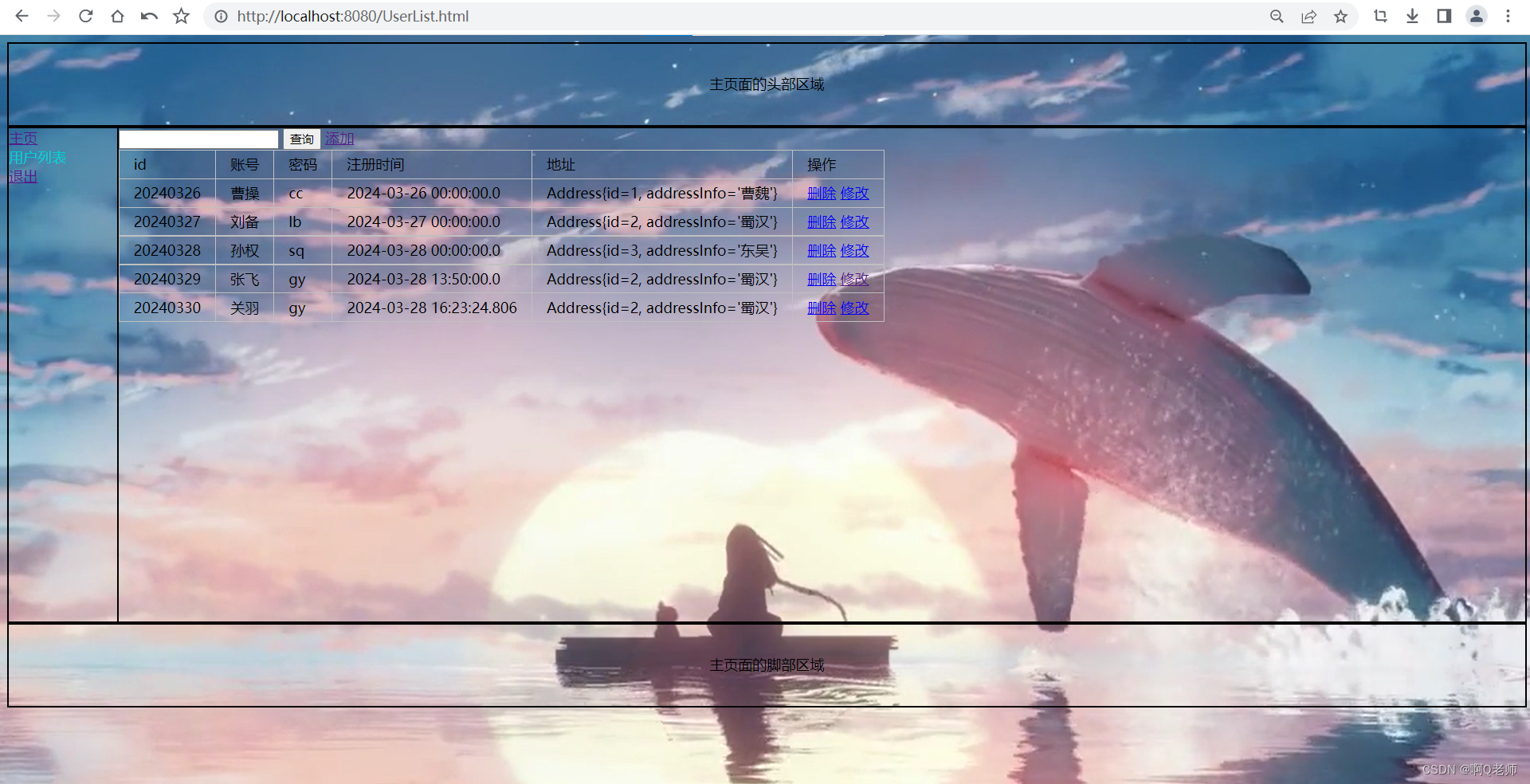
5.在显示用户列表页面上,点击修改,进入修改页面,修改用户信息,点击修改用户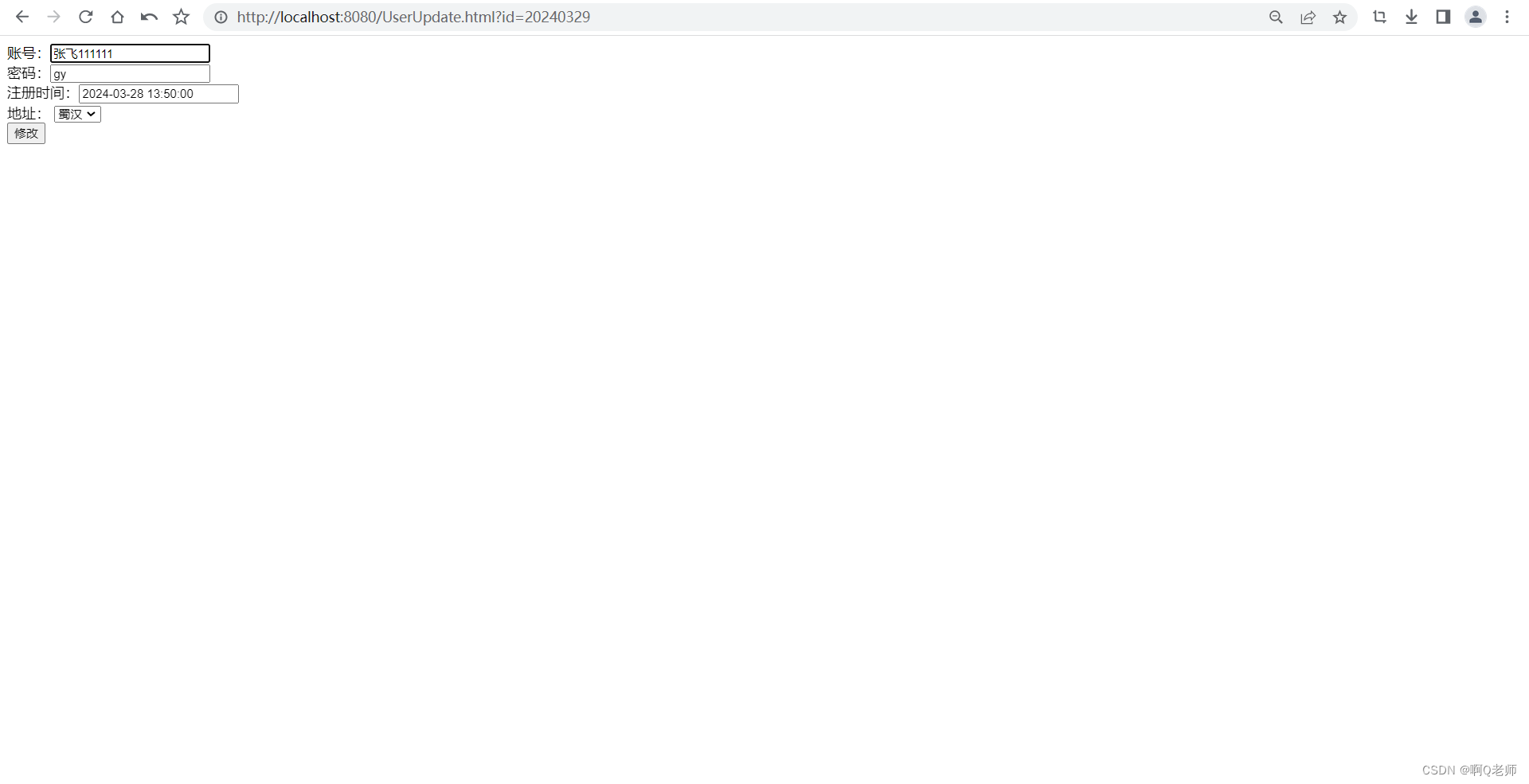 修改用户结果:
修改用户结果: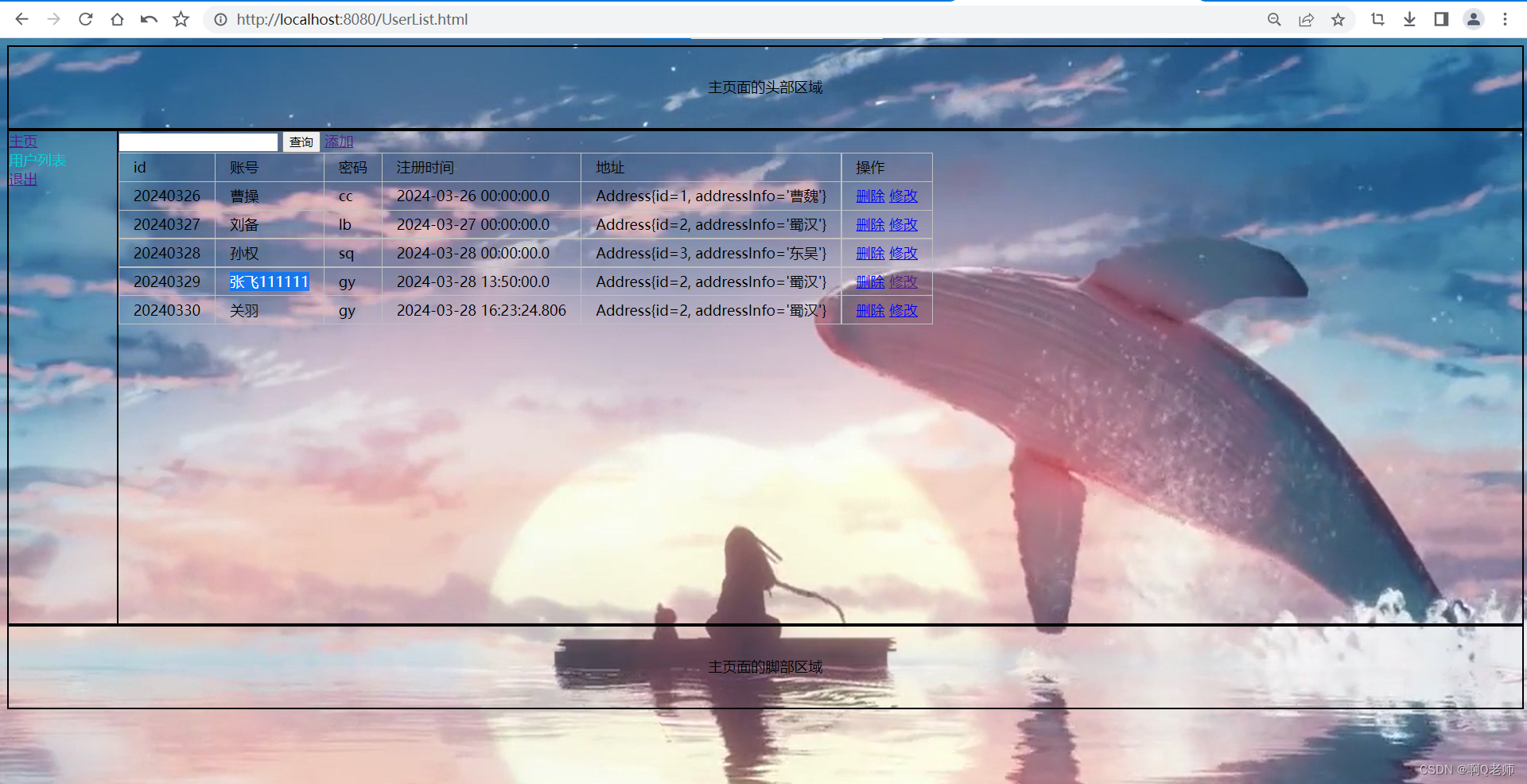
6.在显示用户列表页面上,点击删除,弹出确认窗口,点击确定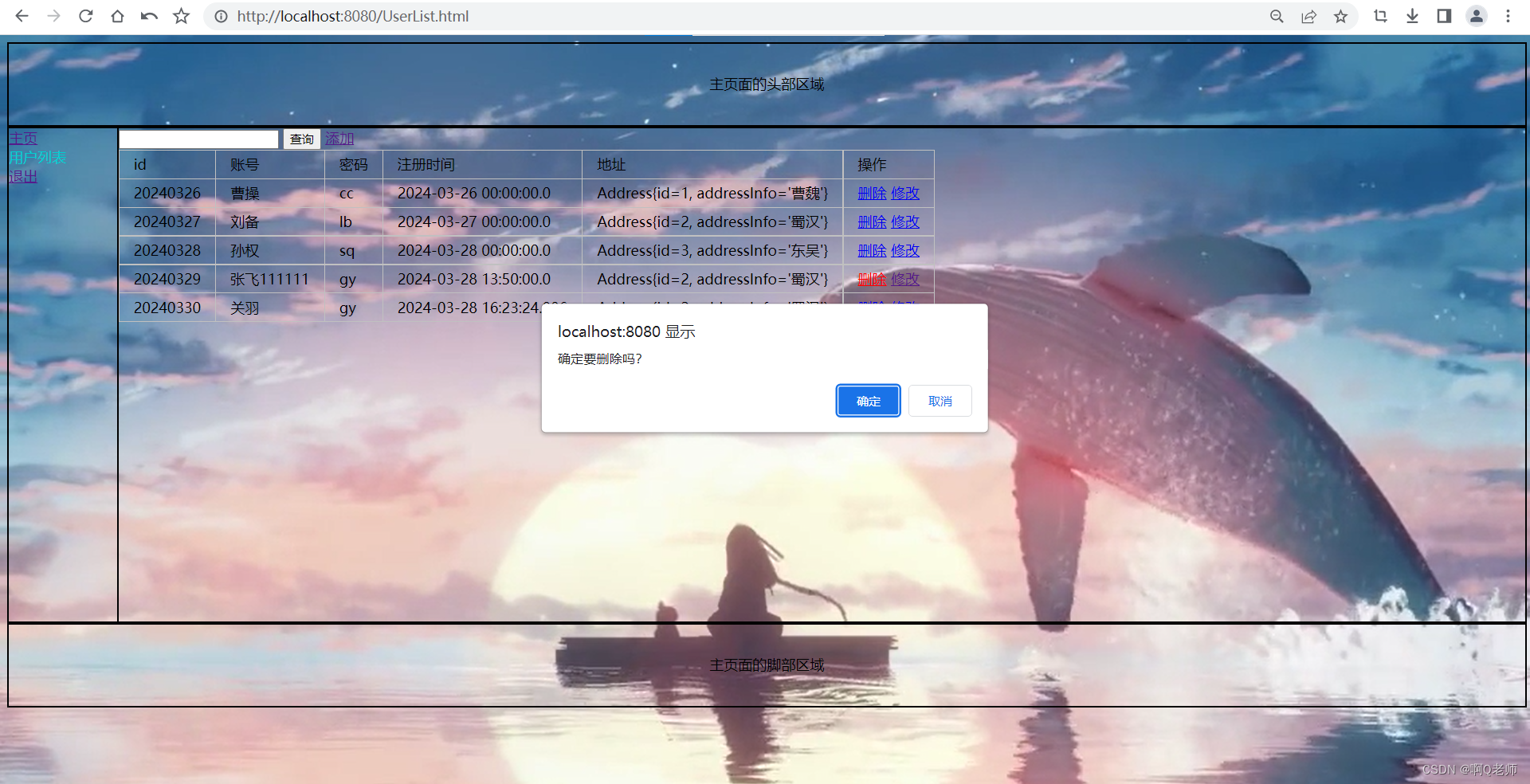 删除用户结果:
删除用户结果:
PublicCss.css:设置页面样式的文本文件
body{
background-image: url("../img/background-image.png");
background-attachment: fixed;
background-size: cover;
background-repeat: no-repeat;
}
.header{
text-align: center;
height: 90px;
line-height: 90px;
width: 100%;
border: 2px black solid;
}
.center{
width: 100%;
height: 450px;
}
.center .sidebar{
width: 120px;
height: 550px;
float: left;
border: 2px black solid;
}
.center .main{
width: 100%;
height: 550px;
border: 2px black solid;
}
table{
border-collapse: collapse;
}
th, td {
border: 1px silver solid;
padding: 0.3em 1em;
}
.footer{
text-align: center;
height: 90px;
line-height: 90px;
width: 100%;
border: 2px black solid;
}
/* 增强效果设置 */
.active{
color: darkturquoise;
text-decoration: none;
}
以上就是关于Spring Boot:Web应用开发之增删改查的实现相关的全部内容,希望对你有帮助。欢迎持续关注程序员导航网,学习愉快哦!

















